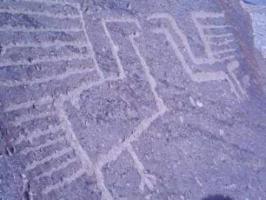Copy Link
Add to Bookmark
Report
MiniSport Laptop Hacker 08

MiniSport Laptop Hacker - Vol 8
28 Feb 93
>>> POOR MAN'S PACKET (PMP) ON THE MINISPORT.
Hallelujah! I got it working! I have a complete TNC built on a little
perfboard. It slides in the left side of the MiniSport in place of the
land-line modem Zenith sold with the computer. As soon as I finish the
series on the COMx: ports, I'll cover how this information was used to make
a complete packet station *inside* the MiniSport (minus a handheld).
>>> MINISPORT LAPTOP COM2 PINOUT
Take the cover off the modem slot on the left side of your MiniSport. If
you have a modem in place, slide it out. Inside you'll see a 16-pin con-
nector:
1 3 5 7 9 11 13 15 (Viewed looking in the slot, right side up)
2 4 6 8 10 12 14 16
The pins are as follows:
1 +5v output
2 +10v output
3 -10v output
4 GND
5 TTL signal (or power supply?). High when CMOS setup turns COM2 on.
Alternately the command line MACHINE MODEM ON lets you set it to high;
MACHINE MODEM OFF sets it to low.
6 Carrier Detect, TTL input.
7 Received Data, TTL input.
8 GND
9 Transmit Data, TTL output.
10 Associated with the built-in computer speaker. Touching to +5v
through a 1kohm resister makes the speaker squawk.
11 ?? ground ??
12 Ring Indicator, TTL input.
13 Data Terminal Ready, TTL output.
14 Clear to Send, TTL input.
15 Request to Send, TTL output.
16 Data Set Ready, TTL input.
>>> COM I/O ARCHITECTURE
In Volume 7, the addresses of the COM I/O ports were given. Now I'll start
discussing to what each of the nine registers actually allows access. I'll
refer to a BASE address. In the case of COM1, this is 0x03F8. In the case
of COM2, this is 0x02F8. I'll cover them in relative order of popularity.
Receiver Buffer Register and Transmitter Holding Register (BASE+0)
------------------------------------------------------------------
These two registers appear at the same address. The receive buffer is read
only; the transmit buffer is write only (makes sense!). This is where you
read the actual byte received over the COM port or where you write the data
you want to send out over the COM port.
CAUTION: BASE+0 will access these registers if and only if the most signif-
icant bit of the LCR (BASE+3) is zero.
Modem Control Register (BASE+4)
-------------------------------
This register allows you to control certain output wires from the 8250.
Normally, you'll write to this address, but you can read the register back
in if you want to find the state of certain bits.
Bit 0: This bit controls the Data Terminal Ready output. When set to a 1,
DTR is "true." This corresponds to a low TTL level, normally in-
verted to become +12v at pin 4 of a DB-9 connector. PMP oscillates
this line to control the mark/space output of the modem. When this
bit is set to 0, PMP receives a high TTL level, providing a 1200Hz
mark frequency.
Bit 1: This bit controls the Request to Send output. When set to a 1, RTS
is "true." This corresponds to a low TTL level, normally inverted
to become +12v at pin 7 of a DB-9 connector. PMP uses this as the
PTT line output. PMP Key down is selected by writing a 0 to this
bit.
Bit 2: This controls an OUT1 line, not normally used in the PC environment.
The output is inverted like the above two. Setting the bit to 0
(zero) gives high TTL output.
Bit 3: This controls an OUT2 line, not normally used in the PC environment.
The output is inverted like the above lines. Setting the bit to 0
(zero) gives high TTL output.
Bit 4: Provides a loopback feature. Set to 0 for normal operation.
Bit 5 - 7: Writing to these has no effect. Reading these bits will always
provide 0 (zero).
Modem Status Register (BASE+6)
------------------------------
This register lets you check on the status of certain control lines re-
ceived by your computer.
Bit 0 - 3: These are edge sensitive versions of the following four bits.
Whenever any of the following four bits change state, the
corresponding bit from this set goes to 1. Reading the MSR sets all
four bits back to zero.
Bit 4: This Clear to Send (CTS) bit is 1 when a low TTL level is presented
to the UART. This normally corresponds to a +12v received on pin 8
of the IBM/PC 9-pin connector. Used by PMP to monitor the
mark/space status of the data stream coming in. An incoming space
(2200Hz) will give a 1 when you read this bit.
Bit 5: Data Set Ready (DSR) is 1 when a low TTL is presented to the UART,
corresponding to pin 6 of the DB-9 being held at +12v. PMP uses this
as a Carrier Detect line. It expects a 0 when the modem is receiv-
ing either a mark or space tone.
Bit 6: Ring Indicator. Logic the same as above two, provided into pin 9 of
the DB-9 by whatever is hooked to it.
Bit 7: Received Line Signal Detect. Logic is the same as above three, with
no normal connection in the IBM/PC environment.
>>> UPCOMING
8250 DOCS, SERIAL & PARALLEL BUFFER CHIP PINOUTS, PMP SCHEMATIC, SHRINKING
YOUR FAVORITE SOFTWARE, MINIMUM BOOT FILES, BOARD REVISIONS, and more DIS-
ASSEMBLY.
73, Brian, ka9snf@wb7nnf.#spokn.wa or Internet ka9snf@jupiter.spk.wa





















